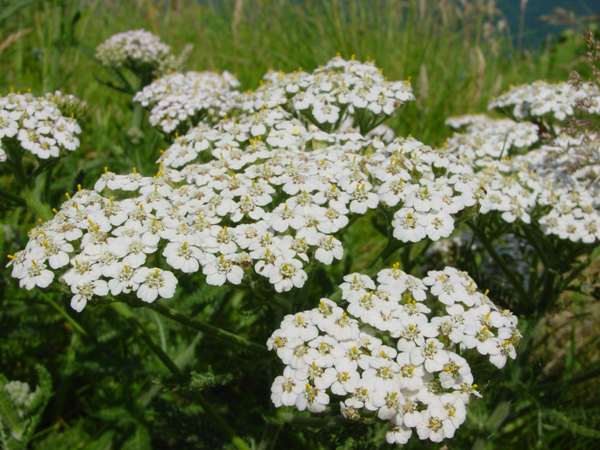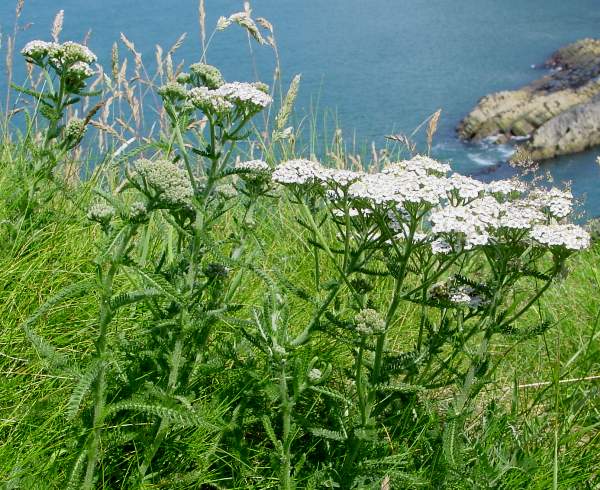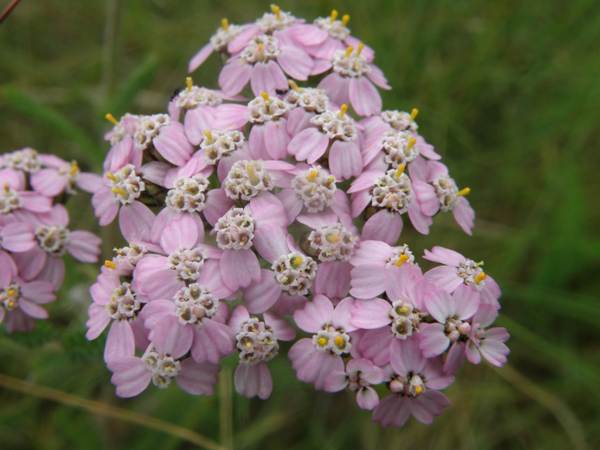Trees Birds Mammals Fish Amphibians Reptiles
Wild Algarve
Bookshop
Achillea millefolium - Yarrow
Phylum: Magnoliophyta - Class: Equisetopsida - Order: Asterales - Family: Asteraceae
Identification - Distribution - Habitat - Blooming Times - Reproduction - Uses - Etymology - Varieties - Similar Species

Yarrow produces flat-topped inflorescences, and as a result it is sometimes mistaken for one of the umbellifers (Apiaceae). In fact Yarrow is a member of the daisy family, Asteraceae.
Description
The plants have feathery leaves arranged around the stems, which can grow up to a metre but are usually less than 0.5m tall, and an inflorescence comprises three to eight (usually five) roundish ray flowers surrounding between 15 and 40 tiny disc flowers.

Distribution
Yarrow is very common throughout Britain and Ireland, and it occurs also across Europe and Asia as well as in North America.
Habitat
This wayside wildflower is found mainly on drier slopes and meadows as well as on many grassy roadside verges.
Blooming Times
Achillea ptarmica blooms in Britain and Ireland from June until October, and is generally at its best in July and August.
Reproduction
Yarrow can reproduce either by means of seeds or by vegetative means. The oblong to lance-shaped fruits of Yarrow are about 2mm long, flattened, and ribbed longitudinally.

Each fruit of Yarrow, known as an achene, contains a single seed, but reproduction is also achieved vegetatively by means of underground creeping stems known as rhizomes, from which new plants (which are therefore clones of the parent plant) arise.
Uses
Considered a plant of the devil in Wales, this wildflower has long been thought to bring bad luck (or even death) if its flowers are brought in to a home. Yarrow is, in any case,
There are many traditional medical uses recorded for this plant, including its use as an astringent to cure bleeding noses.
Herbal tea can be made from the flowers, although given its known medical properties this practice seems rather inadvisable.
(We strongly advise against eating or using as medicines any plants without first obtaining qualified professional advice.)

Etymology
The generic botanical name Achillea stems from the belief that Achilles used Yarrow to treat the wounds of his soldiers. The finely divided leaves give it its specific name (millefoilium means 'with 1000 leaflets').
Varieties
Most Yarrow flowers are white or cream, but some have a mauve flush or occasionally a purple tinge. Other colour forms seen in the wild are almost certainly the result of garden escapes.
In Scandinavia a red-flowered form of Yarrow is found occasionally in the wild. It is not a separate species nor even a subspecies but rather merely a hereditary colour variant; however, selective breeding in cultivation has enabled nurseries to produce Yarrow cultivars raging through white, cream and yellow to mauve, purple, pink and red.
Similar Species
Sneezewort, Achillea ptarmica, has larger flowers (and fewer of them) with eight petals or occasionally more; it grows in damp grassland sites.
Sue Parker's latest ebook is a revised and enlarged edition of Wild Orchids in The Burren. Full details here...
Buy it for just £5.95 on Amazon...
Sue Parker's new ebook is a comprehensive and fully revised edition of her acclaimed field guide to the Wild Orchids of Wales. Full details here...
Buy it for just £5.95 on Amazon...
Please Help Us: If you have found this information interesting and useful, please consider helping to keep First Nature online by making a small donation towards the web hosting and internet costs.
Any donations over and above the essential running costs will help support the conservation work of Plantlife, the Rivers Trust and charitable botanic gardens - as do author royalties and publisher proceeds from books by Pat and Sue.